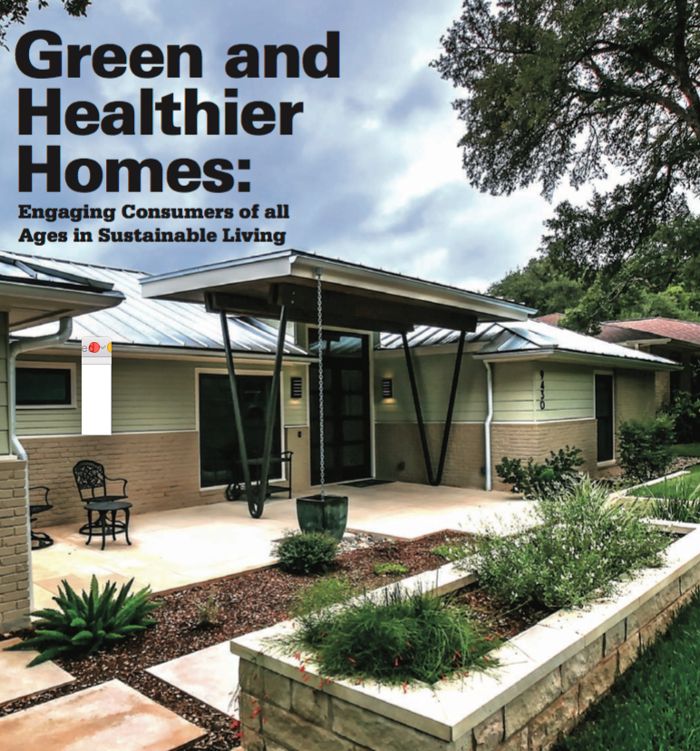
Homebuyers have higher expectations now than they did just a few years ago, and builders are responding with more houses that meet green building standards, a new study from Dodge Data & Analytics says.
More than half of the builders surveyed expect more than 60% of the houses the build will be green by 2020, with 36% of remodelers expecting to meet the same standards in their projects by then.
Although three-quarters of the builders say meeting green standards costs at least 5% more than conventional construction, most of them think consumers are willing to pay more for a house that uses less energy, is more durable, and has better indoor air quality.
Exactly what constitutes a “green” home? As defined by the study, green building refers “specifically to homebuilding, home remodeling/renovating and land development that incorporates environmentally sensitive site planning, resource efficiency, energy and water efficiency, improved indoor environmental quality, and homeowner education, or projects the would comply with the ICC 700 National Green Building Standard or other credible rating systems.”
In other words, there’s still a lot of room for interpretation.
Findings are based on an online survey of builders and remodelers as represented in the membership data base of the National Association of Home Builders. A total of 249 responses are included, from 177 single-family builders and developers, 55 single-family remodelers and 17 multifamily firms.
Banking on baby boomers
“Mature” homebuyers, those 55 and older, pay closer attention to energy efficiency, indoor environmental quality and durability in housing than younger home buyers, the report says. But the millennial generation may eventually catch up.
“The baby boomer generation is large and relatively affluent, which supports a stronger
green market currently, but there are also indications that demand may grow among millennials,” the report says.
For for now, the baby boomers are in the driver’s seat. For example, 81% of buyers over the age of 36 consider energy efficiency an influential factor, compared with 70% of buyers between the ages of 18 and 35. Sixty-seven percent of those 55 or older think a healthier indoor living environment is important, compared with 55% of those 36-54 and only 49% of those in the 18-to-35 age bracket. Durability? Seventy-two percent of those 55 and up think its important; 47% of the 18-to-35 year olds would agree.
The relative wealth of older homebuyers may help explain why builders plan more green projects in the years ahead even as more of them believe it costs more. In 2011, a Dodge report found 58% of builders responding to a like survey thought green building cost at least 5% more than conventional construction. That grew to 60% in a 2014 survey, and to 77% in the most recent report.
But the disparity in income between different age groups was only part of it. The study also found older buyers had more experience with houses, and the more they knew about high-performance features the more likely they were to make that a consideration in future buying decisions.
Builders and remodelers said 83% of homebuyers would be willing to spend more for a healthier home, and the number of buyers willing to spend 5% to 10% more for a green home rose from 26% in 2011 to 33% this year. Still, costs remain a concern.
“The issue of cost must be addressed by the industry in order to see the full potential of the green market achieved,” the authors said, “especially as consumers have there expectation that a new home is green and therefore may not be willing to pay a premium for that level of performance.”
More reliance on renewable energy
All types of renewable energy have grown more common. In the two-year period between 2013 and 2015, the percentage of projects with photovoltaics (PV) jumped from 12 to 19, but the real growth appears still to be in the future. Houses equipped with PV will grow to 48% of the market by 2018, builders and remodelers said, while solar hot water heating would increase to 41%, and ground-source heating equipment would rise to 52% of their projects.
More than 20% of the builders surveyed said they had built a net-zero or net-zero ready home, and 58% of the builders who report 90% or more of their projects are green are doing net-zero or net-zero ready construction.
The interest in renewables seems driven by practicality: while 81% of buyers 55 and older were judged to be influenced by energy efficiency, only 8% of those in that age bracket gave much weight to a reduced carbon footprint. By contrast, 12% of those 18-35 considered a reduced carbon footprint influential, builders said.
Read more: http://www.greenbuildingadvisor.com/blogs/dept/green-building-news%2A#ixzz3t5OGLB3G
Follow us: @gbadvisor on Twitter | GreenBuildingAdvisor on Facebook
Fine Homebuilding Recommended Products
Fine Homebuilding receives a commission for items purchased through links on this site, including Amazon Associates and other affiliate advertising programs.

Handy Heat Gun

Affordable IR Camera

Reliable Crimp Connectors

A new report shows growing interest among home builders and remodelers in meeting green standards despite the perception it costs more. Buyers are willing to pay for it.























View Comments
This is inevitable given how much big companies invest in renewable energy and that it is expected to completely replace the all else. And of course people would like to pay a little for a house that "is more durable, and has better indoor air quality". Great article!